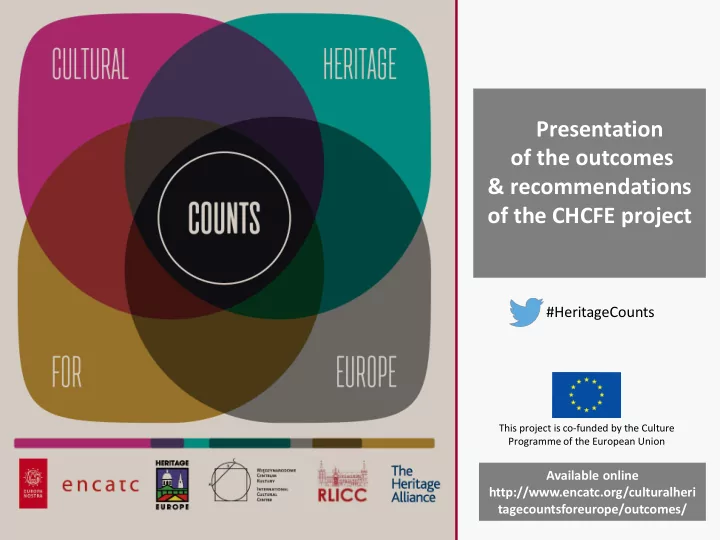

Concluding Presentation of the outcomes Conference & recommendations of the CHCFE project 12 June 2015 Oslo, Norway #HeritageCounts This project is co-funded by the Culture Programme of the European Union This conference is also supported by Available online http://www.encatc.org/culturalheri tagecountsforeurope/outcomes/
Presentation of the Key Findings & Recommendations of the CHCFE Project Prof. Koenraad Van Balen Council Member of Europa Nostra Director of the Raymond Lemaire International Centre for Conservation, KU LEUVEN (BE)
Group photo of the participants in the Cultural Heritage Counts for Europe conference, Aula of the Domus Media of Oslo University, 12 June 2015
The project The Consortium • Europa Nostra (project coordinator) • International Cultural Centre (Krakow) – research partner • Raymond Lemaire International Centre for Conservation (KU Leuven, Belgium) – research partner • ENCATC (The European Network on Cultural Management and Cultural Policy Education) • Heritage Europe – EAHTR (European Association of Historic Towns & Regions) • Heritage Alliance (partnership institution from Great Britain)
Aims of the project • to collect and analyse existing and accesssible evidence-based research and case studies regarding the economic, social, cultural and environmental impacts of cultural heritage; • to identify gaps in information and areas of possible future research; and • to develop policy recommendations for tapping into the full potential of cultural heritage.
4 pillars approach of sustainable development Based on UNESCO’s Hangzhou declaration on Sustainable Development
Growing interest in cultural heritage impact research
Towards a Holistic Approach to Cultural Heritage Impact Research
The 10 Key Findings 1. Cultural heritage is a key contributor to the attractiveness of Europe’s regions, cities, towns and rural areas • in terms of private sector inward investment • developing cultural creative quarters • attracting talents and footloose businesses enhancing regional competitiveness both within Europe and globally.
Temple Bar in Dublin, Ireland
The 10 Key Findings 2. Cultural heritage provides European countries and regions with a unique identity • creates compelling city narratives providing the basis for effective marketing strategies aimed at developing cultural tourism and attracting investment.
Museo Ferrari near Modena in Italy
The 10 Key Findings 3. Cultural heritage is a significant creator of jobs across Europe, covering a wide range of types of job and skill levels: • conservation-related construction, repair and maintenance • cultural tourism • small and medium-sized enterprises and start-ups - often in the creative industries.
Source: Prof. dr. C. Gustaffson
The 10 Key Findings 4. Cultural heritage is an important source of creativity and innovation: • generating new ideas and solutions to problems • creating innovative services - ranging from digitisation of cultural assets to exploiting the cutting-edge virtual reality technologies • with the aim of interpreting historic environments and buildings and making them accessible to citizens and visitors.
Tate Modern in London, UK
The 10 Key Findings 5. Cultural heritage has a track record: • in providing a good return on investment • is a significant generator of tax revenue for public authorities and • through spill- over from heritage-oriented projects leading to further investment.
UNESCO Heritage Site of Pont du Gard in France
The 10 Key Findings 6. Cultural heritage is a catalyst for sustainable heritage-led regeneration.
Grainger Town in Newcastle, UK
The 10 Key Findings 7. Cultural heritage is a part of the solution to Europe’s climate change challenges • for example through the protection and revitalisation of the huge embedded energy in the historic building stock.
Borgund stave church in Norway
The 10 Key Findings 8. Cultural heritage contributes to the quality of life, providing character and ambience to neighbourhoods, towns and regions across Europe, • making them popular places to live, work in and visit • making them attractive to residents, tourists and the representatives of creative class alike.
Jamtli indoor and open-air museum in Sweden
The 10 Key Findings 9. Cultural heritage provides an essential stimulus to education and lifelong learning • including a better understanding of history • as well as feelings of civic pride and belonging, and • fosters cooperation and personal development.
Pszczyna Castle in Poland
The 10 Key Findings 10. Cultural heritage combines many of the above-mentioned positive impacts to build social capital and help deliver social cohesion in communities across Europe: • providing a framework for participation and engagement • fostering integration.
De Hoorn, Leuven Heritage Award: www.youtube.com/watch?v=8J3x4Fuh8LQ&feature=youtu.be
5 Strategic Recommendations 1. Supporting Evidence-based Policy Making 2. Measuring Impact 3. Monitoring Trends 4. Sharing and Disseminating Data 5. Maximising Impact
Downstream approach
Lessons learned Obnovme si svoj dom / Let’s restore our home − Collaboration between the Slovak Republic’s Ministry of Culture and Ministry of Labour, Social Affairs and Family, with support of the European Social Fund − The project operates with unemployed citizens who, together with the active participation of civic associations, restore selected state owned monuments − Open to civil society organisations, foundations and municipalities in the Bratislava Region. Positive effects: Exhausting → Decreasing the unemployment rate in regions with low removal of the economic productivity cement mortar → integrating the long-term unemployed into the heritage ( Ižvolt and conservation sector, through connection with regional Smatanová 2014) traditions and local citizens’ cultural values → Creating more employment in the service sector
Upstream approach
THANK YOU FOR YOUR ATTENTION! Q? koenraad.vanbalen@bwk.kuleuven.be aziliz.vandesande@bwk.kuleuven.be Raymond Lemaire International Centre for Conservation (KU Leuven) Department of Civil Engineering Kasteelpark Arenberg 40 - box 2448 3001 Leuven, Belgium
Recommend
More recommend